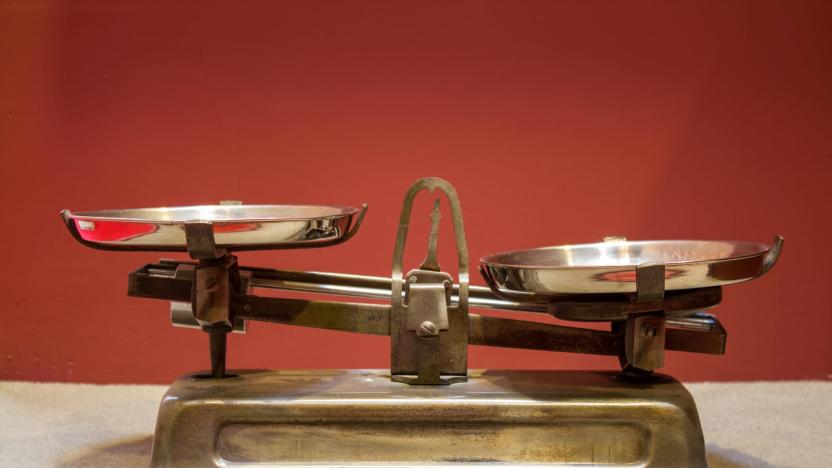planck
Latest

On May 20th, the kilogram will no longer be defined by a lump in France
On May 20th, World Metrology Day, the scientific community will officially change the definition of the kilogram. For 130 years, the kilo has been defined by a physical cylinder of platinum-iridium alloy, known as Le Grand K and stored in a vault outside of Paris. But every time scientists handled it, the cylinder lost atoms -- an estimated 50 micrograms over its lifetime. So, beginning Monday, the kilogram will officially be measured by a physical constant known as the Planck constant.

Why scientists are redefining the kilogram
Physics is a funny thing. Despite dictating the behaviors and states of everything from atoms to stars, our interpretation of its effects are rooted in very human constructs. Meters, amperes and seconds were all defined using arbitrary terms and methods. For years, the kilogram and meter weren't just terms, they were physical objects held in a Paris vault that some Victorian-era committee just decided would be the standard. But now, for the first time since the international system of units (SI) was launched in 1960, the International Bureau of Weights and Measures (BIPM) is redefining four basic units of measurement, not by any human metric but by the immutable forces of the universe. "This is the most important decision that the BIPM has made in maybe 100 years, which may be a slight exaggeration, but at least since 1960 when they adopted the international system of units," Dr. Terry Quinn, emeritus director of the BIPM, said. A committee from the BIPM met in Paris this week and voted on Friday to recommend redefining the kilogram, mole, ampere and Kelvin. The motion will be put up for a vote at the General Conference on Weights and Measures (CGPM) next November. "For the scale that's in your grocery store or bathroom, nothing's going to change," Dr. David Newell of the National Institute of Standards and Technology (NIST) said. Instead, as Dr. Quinn explains, "it will give you the ability to make accurate measurements on scales far different from the current scale."

Planck space telescope retires from observing the early universe
After nearly 4.5 years of watching the stars, the Planck telescope is officially out of action. European Space Agency scientists have shut off the observation satellite now that it has both finished its mission and parked in a "permanent hibernation" orbit around the Sun. The telescope accomplished a lot during that short lifespan, however -- by creating a detailed map of cosmic background radiation, Planck gave us a snapshot of the early universe that will help us understand the evolution of space. Researchers still haven't finished studying Planck's findings, which suggests that the spacecraft's legacy will last well beyond the final transmission.

Planck satellite creates most detailed map ever of cosmic microwave background radiation
The European Space Agency's Planck satellite has been gathering data since its launch in 2009, slowly building up a map of the cosmic microwave background radiation -- a distant remnant of the Big Bang. The resulting image, seen above, is the most detailed ever put together of the cold glow that uniformly covers the universe, taking us all the way back to just a 380,000 years after the explosive inflation that gave birth to all matter, energy and time. There were some surprises, including more extreme temperature fluctuations between hemispheres than predicted by the standard model and confirmation of a pronounced cold spot that can no longer be dismissed as an artifact of previous satellite instruments. For more about just what Planck has taught us, along with a few more visualizations, check out the source link.

Planck trailer is music to our eyes
We haven't heard too much yet about Planck, Shadegrown Games' music-based shooter, but this video should go a long way towards explaining exactly how it works. As you see after the break, the idea is that you're traveling along shooting items that release "trapped" sounds, building a music track as you move along. There's also a sort of boss battle at the end, though this interview with Shadegrown's Matthew Burns hints that it's a "special encounter," designed to play with the tone of the music rather than the notes themselves. Sounds interesting. Shadegrown hasn't mentioned a release date target or even platforms for the title yet, but we'll keep our ears open and let you know when we hear something about it. Because it's a music game. Which you listen to. Get it? Update: Shadegrown has given us both a platform and a date for release: The game will be out for PC (with other platforms to come) and probably in 2012.

What's in a Name: Shadegrown Games
It's time for another origin story of an industry presence. Today, it's Matthew Burns who isn't quite sure if choosing Shadegrown Games makes him a hippie or a yuppie: I worked on big-budget titles in the game industry for about 10 years. I was a producer on the Halo series at Bungie, and before that I worked at Activision on Call of Duty. When you work on that games that big, the business really comes down to economies of scale: you have to sell millions of copies to recoup the millions of dollars you spent on making the thing. So people get pretty risk-adverse... there's hundreds of employees and millions on the line, so everyone retreats to tried-and-true themes, proven gameplay mechanics, and so on. When I left to start my own company, I wanted to be weird and make games that people hadn't seen before– explore some of the ideas I had about game design, interactive music and other aspects of development. I had a few dozen words and phrases I wrote down to express these kinds of concepts, but none of them were really sticking.

Planck telescope maps the universe in search of primordial light
Yep, that innocuous-looking picture above is the whole freaking universe, as perceived by the Planck telescope -- a long-wave light detector that's been catapulted into space to search for Big Bang clues. The European Space Agency is using it in order to get the most precise information to date on Cosmic Microwave Background radiation (apparent in the image as the magenta and yellow mush in the, ahem, background), which could in turn enlighten us on the conditions that gave rise to all of us omnivores prowling a gravity-assisted, ozone-protected, floating rock. The first mapping run took just over six months to complete, but the plan is to produce four such images using the Planck's super-cold (nearly at absolute zero) sensors before retiring the thing. Results are expected no sooner than 2013, so please do slide back from the edge of your seat.





